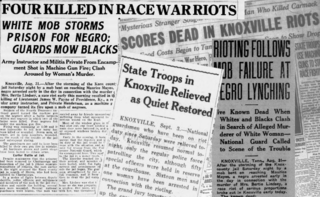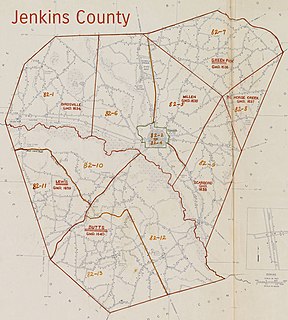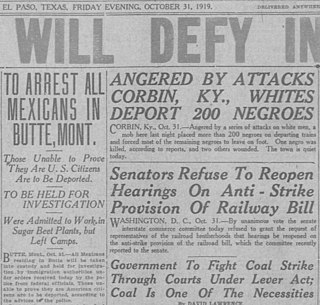
The Knoxville riot of 1919 was a race riot that took place in the American city of Knoxville, Tennessee, on August 30–31, 1919. The riot began when a lynch mob stormed the county jail in search of Maurice Mays, a biracial man who had been accused of murdering a white woman. Unable to find Mays, the rioters looted the jail and fought a pitched gun battle with the residents of a predominantly black neighborhood. The Tennessee National Guard, which at one point fired two machine guns indiscriminately into this neighborhood, eventually dispersed the rioters. At the end of August 1919 the Great Falls Daily Tribune reported four killed in a "race war riot" while the Washington Times reported "Scores dead." Other newspapers placed the death toll at just two, though eyewitness accounts suggest it was much higher.

The Washington race riot of 1919 was civil unrest in Washington, D.C. from July 19, 1919, to July 24, 1919. Starting July 19, white men, many in the United States Army, United States Navy, and United States Marine Corps, responded to the rumored arrest of a black man for rape of a white woman with four days of mob violence against black individuals and businesses. They rioted, randomly beat black people on the street, and pulled others off streetcars for attacks. When police refused to intervene, the black population fought back. The city closed saloons and theaters to discourage assemblies. Meanwhile, the four white-owned local papers, including the Washington Post, fanned the violence with incendiary headlines and calling in at least one instance for mobilization of a "clean-up" operation. After four days of police inaction, President Woodrow Wilson ordered 2,000 federal troops to regain control in the nation's capital. But a violent summer rainstorm had more of a dampening effect. When the violence ended, 15 people had died: at least 10 white people, including two police officers; and around 5 black people. Fifty people were seriously wounded and another 100 less severely wounded. It was one of the few times in 20th-century riots of whites against blacks that white fatalities outnumbered those of black people. The unrest was also one of the Red Summer riots in America.

Berry Washington was a 72 year old black man who was lynched in Milan, Georgia, in 1919. He was in jail after killing a white men, during a fight, who was attacking two young girls. He was taken from jail and lynched by a mob.

The Charleston riot of 1919 took place on the night of Saturday, May 10, between members of the US Navy and the local black population. They attacked black individuals, businesses, and homes killing six and injuring dozens.

The Jenkins County riot of 1919 took place on Sunday, April 13, 1919, when a series of misunderstandings and out-of-control events spiralled into two white police officers being killed. In retaliation the local white community formed mobs and ravaged the black community, burning black community buildings and killing at least four people.

The Macon, Mississippi, race riot took place on June 7, 1919, in Macon, Mississippi. Members of the white community were angry that some people were organizing to fight for better work conditions and so beat, whipped and then forced them into exile.

The New London riots of 1919 were a series of racial riots between white and black Navy sailors and Marines stationed in New London and Groton, Connecticut.

The Dublin, Georgia riot of 1919 were a series of violent racial riots between white and black members of Dublin, Georgia.

The Garfield Park riot of 1919 was a race riot that began in Garfield Park in Indianapolis, Indiana on July 14, 1919. Multiple people, including a seven-year-old girl, were wounded when gunfire broke out.

The Syracuse riot of 1919 was a violent racial attack that occurred when the management of the Globe Malleable Iron Works pitted striking white unionized workers against black strikebreakers in Syracuse, New York on July 31, 1919.

The Darby 1919 lynching attempt was the attempted lynching of Samuel Gorman in Darby, Pennsylvania on July 23, 1919. Samuel Gorman, a 17-year-old black boy was sent to jail for the alleged murder of William E. Taylor.

Corbin, Kentucky race riot of 1919 was a race riot in 1919 in which a white mob forced nearly all the town's 200 black residents onto a freight train out of town, and a sundown town policy until the late 20th century.

There were a number of race riots in Philadelphia during the 1919 Red Summer.

The New York race riots of 1919 developed with increasing racial tension and violent incidents in New York City. These riots were a part of the Red Summer, a series of violent terrorist attacks on black communities in many cities in the United States during the summer and early autumn of 1919. The New York race riots were caused by social tensions such as competition for jobs, politics, and racial tension. Many historians and scholars view these riots as the culmination of racial tensions which had been rising due to the migration of African Americans from the rural South to northern cities. Tensions developed partly due to the competition for jobs, which was worsened by the presence of African Americans workers who could replace striking White workers.

The Laurens County, Georgia race riot was an attack on the black community by white mobs in August of 1919. In the Haynes' report, as summarized in the New York Times, it is called the Ocmulgee, Georgia race riot.

The Whatley, Alabama race riot of 1919 was a riot, gun battle between the local Black and White community on August 1, 1919.

Miles Phifer and Robert Crosky were lynched in Montgomery, Alabama for allegedly assaulting a white woman.

The Bogalusa saw mill killings was a racial attack that killed four labor organizers on November 22, 1919. It was mounted by the white paramilitary group the Self-Preservation and Loyalty League (SPLL) in Thibodaux, Louisiana. They were supported by the owners of Great Southern Lumber Company, a giant logging corporation, that hoped to prevent union organization and the Black and White labor organizations from merging.

Chilton Jennings was lynched on July 24, 1919, after being accused of attacking a white woman, Mrs. Virgie Haggard in Gilmer, Texas.

On December 26, 1920, an African-American man named Wade Thomas was lynched in Jonesboro, Arkansas, by a white mob. The mob seized Thomas from the Jonesboro jail after he allegedly shot local Patrolman Elmer Ragland, and murdered him.




















